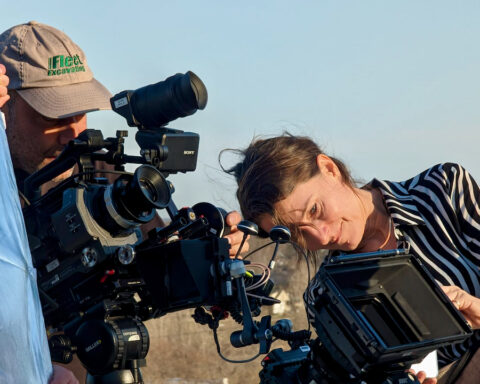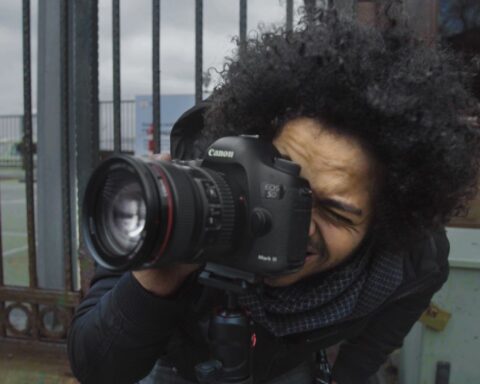BACK IN 2010, when I was last summoned by POV to deliver a précis on the state of the documentary community in the US, we Americans were in the throes of the Great Recession, but still basking in the faint glimmer of hope that the Obama Administration had first brought two years earlier. The documentary community, which had, for much of the 2000s, experienced a sea change in relevance, visibility and viability, was certainly feeling the pinch. Consolidation and downsizing were rife among all sectors, and funding opportunities were more and more scant. But docmakers are a stalwart and scrappy lot, accustomed to the exigencies of the long haul and open to improvisation and experimentation. DIY or Die was the header of my essay back then.
And, in many ways, “DIY or Die” is the clarion call three years later, underscored with a sense of both verve and trepidation. I write this essay in the cusp between Canada Day and Independence Day—a fitting period to reflect upon what independence means for the American documentary filmmaker. It means ingenuity and versatility in getting your work made and seen. And it means vulnerability, given the troubling ambivalence among television’s biggest players towards the independent documentary, which, despite its predominance on the festival circuit and during awards season, finds fewer and fewer homes in which to showcase. And it means responsibility, temerity and tenacity in upholding the basic tenets, values and virtues of one of the most vital sub-genres of the documentary form: journalism.
But first, let’s consider the can-do spirit, that tried-and-true, red-white-and-blue maxim that has driven American industries, entrepreneurs and artists since the colonial days. And since 2010, the digital tools of trade for documentary filmmakers have continued to expand possibilities for creativity and commerce. Facebook, Twitter and LinkedIn have, in this souped-up era, attained the level of elder statespeople, while Tumblr, Reddit, Tugg and Slated are quickly coming into their own as vital enablers in connecting filmmakers with their audiences.
Crowdfunding and crowdsourcing, which entered the lexicon in the late 2000s, are now the default positions for the indie community, with Kickstarter and Indiegogo leading the charge, having successfully funded tens of thousands of film projects between them over the past six years. Seed&Spark upped the crowdfunding/crowdsourcing ante with its launch this year, providing a context not only for fundraising, but also for digital distribution. These platforms have empowered the filmmaking community to forge a cost-effective and cost-efficient covenant with supporters and audiences.
And there are the enablers, such as the Sundance Institute and Tribeca Enterprises, both of which have ventured beyond their respective festival paradigms. The Sundance Institute Artist Services program, launched in 2011, has partnered with a plethora of video-on-demand (VOD) distributors, nonprofit media arts organizations and Web-based entities to create a unique ecosystem for self-distribution, funding and marketing. Tribeca Film acquires, markets and distributes films, often after they premiere at the Tribeca Film Festival, across multiple platforms. And the Sundance Documentary Film Program and the Tribeca Film Institute both offer a robust menu of labs and funding opportunities.
While our neighbours to the north have produced a number of ground-breaking Web-based transmedia/multiplatform projects over the years, many in the American documentary community have been hard at work exploring the parameters of HMTL5 through such endeavours as the Living Docs Project, a collaboration involving Mozilla, Independent Television Service (ITVS), the Bay Area Video Coalition (BAVC), the Center for Social Media and the aforementioned Tribeca Film Institute. In addition, Games for Change, a New York-based nonprofit, recently celebrated 10 years of encouraging the production of digital games as a force for social change, and as a complementary mechanism to the dynamics of the documentary form.
The Web continues to grow as a versatile venue for showcasing short-form docs in a variety of ways. The New York Times Op-Docs; Focus Features’ Cinelan; PBS’ Off Book; filmmaker Ondi Timoner’s A Total Disruption: these represent a vital alternative to the traditional windows of distribution—an alternative that has attracted such corporate partners as Fast Company and General Electric.
But despite these promising innovations and opportunities, the prospects of maintaining a decent, if not lucrative, career as a full-time documentary maker are short of inspiring. The monetization of VOD, whether subscription-based, transactional or ad-supported, can be a complicated process in both grasping the economics of this platform and monitoring the various revenue streams—not to mention maintaining an ongoing vigilance for online piracy.
In addition, while an impressive number of docs have crossed the $1-million mark at the box office over the past three years, closer inspection reveals that a good portion of those films are large-screen nature films, which usually draw large crowds. For the most part, the festival circuit continues to serve as a major theatrical showcase—so much so that former Hot Docs programmer Sean Farnel suggested (in a previous issue of POV) that festivals start paying filmmakers. The aforementioned Sundance Institute Artist Services has been a useful means to keep their festival films alive—one case of point is Detropia, the award-winning film from Heidi Ewing and Rachel Grady, who opted to go the self-distribution route after fielding a series of unappealing offers from traditional distributors. The filmmakers launched a Kickstarter campaign to fund their national tour—and exceeded their goal by $12,000. This self-distribution strategy, while certainly exhausting, places the booking and marketing activities firmly in the hands of the filmmaker. Other entities like the online platform Tugg, launched in 2012, help filmmakers build their own theatrical runs, while digital cinema chains such as Fathom Events, known for its event programming of live opera and other performing arts, has taken on a handful of documentaries over the past few years for similar one-night-only treatments.
But the one window that connotes more uncertainty these days, despite a long history of strong support, is television. We have witnessed a worrisome decline in the number of homes for the independent documentary, while the nonfiction series in all of its permutations—reality, unscripted, actuality, competition—has dominated the landscape. Even omnibus series that follow the shining example of, say PBS’s Independent Lens or POV, have a hard time gaining traction with major companies like Discovery Communications or National Geographic. OWN came on the scene in 2011, under the auspices of Discovery, with Oprah Winfrey herself declaring that she wanted to do for documentaries what she had done for books. But a mere 14 months later, Oprah’s Doc Club went into hiatus.
BUT THERE ARE ALWAYS flickers of hope: The 2013 RealScreen Summit, the annual confab for the major players in the industry, did actually open up its schedule to include more representation from the one-offers. And HBO and PBS have long championed the indie doc. Other US channels like Showtime and Epix are pursuing the documentary space more aggressively, while CNN launches its new initiative, CNN Films, this summer. Participant Media, renowned for its robust social action campaigns around theatrical releases of documentaries, makes its television debut, also this summer, with Pivot, a new cable channel that will also have a strong broadband presence. Finally, Al Jazeera, following its high-profile acquisition of Current TV earlier in 2013, has kept a relatively low profile about the programming for its forthcoming Al Jazeera America. But given the impressive track record of award-winning work produced by its English counterpart, the new channel may have potential as a new home for independent, journalism-inclined documentaries.
So while the American documentary community holds out hope for these new ventures, it also casts an anxious eye on its most ardent supporter, PBS, which since the 1960s has served the public with exemplary nonfiction programming. But lately, the stalwart network has withstood some body blows. In April 2012, the National Endowment for the Arts announced its slate of Arts in Media grants, and such flagship PBS programs as Independent Lens, POV, American Masters and Great Performances all suffered substantial cuts, as the agency shifted its priorities in that division to gaming, transmedia and multiplatform projects. This came as stunning news to PBS chief Paula Kerger, who had made arts programming a priority. Then, six months later, during the first US presidential debate, Republican candidate Mitt Romney announced that if elected, he would cut PBS altogether. The right wing has made these threats over the past two decades, but given the deep ideological divide that infects Washington these days, along with the post–Citizens United tsunami of money that drives both campaigns and governance, the execution of such threats may not be so far-fetched.
A recent New Yorker article by Jane Mayer revealed a troubling cautionary tale about what happens when philanthropists wield power beyond their altruistic intentions. Thirteen/WNET, one of the flagship stations in the PBS family, was scheduled to air Alex Gibney’s Park Avenue: Money, Power and the American Dream last November as part of the Independent Lens series. The film, which took aim at conservative billionaires Charles and David Koch, caught the attention of Thirteen/ WNET president Neal Shapiro, given that David Koch sat on the board of the channel. According to Mayer, Shapiro contacted Koch about the film prior to its airing and asked him to participate in a roundtable discussion following the broadcast. Koch declined, but WNET did air a statement from Koch Industries lambasting the film and altered the introduction to the film to underscore its “provocative” nature. Neither Koch nor any or his colleagues had actually seen Park Avenue.
The die was cast, though. Shapiro threatened to stop airing Independent Lens, and Koch resigned from the WNET board, taking his promised seven-figure gift with him. Months later, ITVS, the distribution arm of Independent Lens and a longtime supporter of nonfiction work, withdrew its offer of production licensing from Tia Lessin and Carl Deal’s Citizen Koch, which examines the repercussions of the Supreme Court’s Citizens United decision and its most prominent beneficiaries, the Koch brothers. PBS’s stated editorial policy—“member stations are responsible for shielding the creative and editorial processes from political pressure or improper influence from funders or other sources”—was seemingly at the mercy of the will and whim of private funders.
But once such stakeholders as the Koch brothers cross the line from philanthropy to control, the independent voice and vision that is so crucial to PBS programming is in peril. And you can substitute “journalism” for “PBS programming,” given that the Koch brothers are setting their acquisitive sites on media—namely the Tribune Company, the second largest newspaper company in the country.
AND THIS IS WHERE the American documentary filmmaker has stepped in: as the nimble, dogged, underpaid vanguard of independent journalism and intrepid reporting. Addressing the crowd at the 2010 International Documentary Association’s Awards Gala, filmmaker Joe Berlinger, whose costly legal entanglements with Chevron in the wake of his documentary Crude earned the support of both the documentary and journalism communities, maintained, “While we can debate whether or not it is easier or harder to be a documentarian today, I would argue that being a documentarian today has never been more important…. We documentarians are one of the last bastions of independent journalism. Whether those films show a bias or not, some of the most courageous and important reporting on real problems affecting all of us are being done by this community.”
But independence and journalism, of course, have a price. Two years after Berlinger’s struggles with Chevron over their rights to his entire trove of footage, the City of New York attempted to subpoena footage and background material for The Central Park Five, Sarah Burns, Ken Burns and David McMahon’s work about a sensational rape trial of five innocent men who as teenagers had been scapegoated by the media and the city prosecutors.
And then there’s Laura Poitras. The MacArthur Genius Grant recipient has earned high accolades for the first two films of her projected trilogy about post-9/11 America. My Country, My Country, which follows one man’s long-shot bid in the first post-Saddam election in Iraq, earned an Academy Award nomination. Her second film, The Oath, afforded her access to both Osama bin Laden’s former driver, now based in Yemen, and former bodyguard, now in Guantanamo. And that film got the attention of the US government’s Department of Homeland Security. She’s been stopped at US airports over 40 times, been handcuffed and interrogated, and had her laptop and hard drive confiscated. And while she has had to take extra precautionary measures in safeguarding her work, and even in returning to the United States, that hasn’t stopped her from pursuing her latest work, on whistle-blowers and surveillance, and defending her rights as an American journalist.
Which led Edward Snowden, former contractor with the National Security Agency, to contact her in January 2013 about the agency’s mass surveillance program, according to a piece by Lynn Elber in the Huffington Post. Over the next few months, Poitras, Snowden and journalist Glenn Greenwald mapped out an elaborate, meticulous strategy to get this story out. She and Snowden flew to Hong Kong, where Snowden had fled, and conducted an interview, later posted online, and broke the story through the UK-based Guardian and the Washington Post.
In 2010, seemingly to usher in this era of secrecy and transparency and privacy and security, Judith Ehrlich and Rick Goldsmith premiered their documentary The Most Dangerous Man in America: Daniel Ellsberg and the Pentagon Papers, shining a light on a watershed moment in America’s evolving democratic system, when the US Supreme Court reaffirmed the sanctity of the First Amendment and its protection of the freedom of the press as an instrument in holding our government and its actions up to scrutiny. As the film garnered praise and an Academy Award nomination, Ellsberg was reconstituted as a de facto sage counsel to the likes of Snowden, Bradley Manning and Julian Assange—and an inspiration, perhaps, for filmmakers like Poitras, James Spione, who is also making a film about whistle blowers; and Richard Rowley and Jeremy Scahill, whose Dirty Wars examines America’s covert military strategy.
DEMOCRACY IN AMERICA is a work in progress, as is independence. m Independence also means summoning up the entrepreneurial energy to get a film made and find both a home and an audience for it. And independence means mustering up the temerity to challenge, provoke, inspire and change.











